5 Ways Bloggers Can Use ChatGPT to Increase Productivity


Since ChatGPT’s release in November 2022, OpenAI’s prototype of generative AI — that is, artificial intelligence that can produce new content on demand — has dominated popular tech media.
We’ve all seen the headlines questioning the future of organic search, the impact on creators’ livelihoods and content ownership, the challenge of information authenticity and accuracy. It’s easy to feel anxious about the future of digital publishing.
So, what’s a content creator to do? First, let’s get some perspective.
AI content generators have been around for quite some time, including tools you may have heard of or even used, including Jasper, Copy.ai and Surfer SEO. ChatGPT is the latest iteration of generative AI and moves the technology’s potential several steps forward.
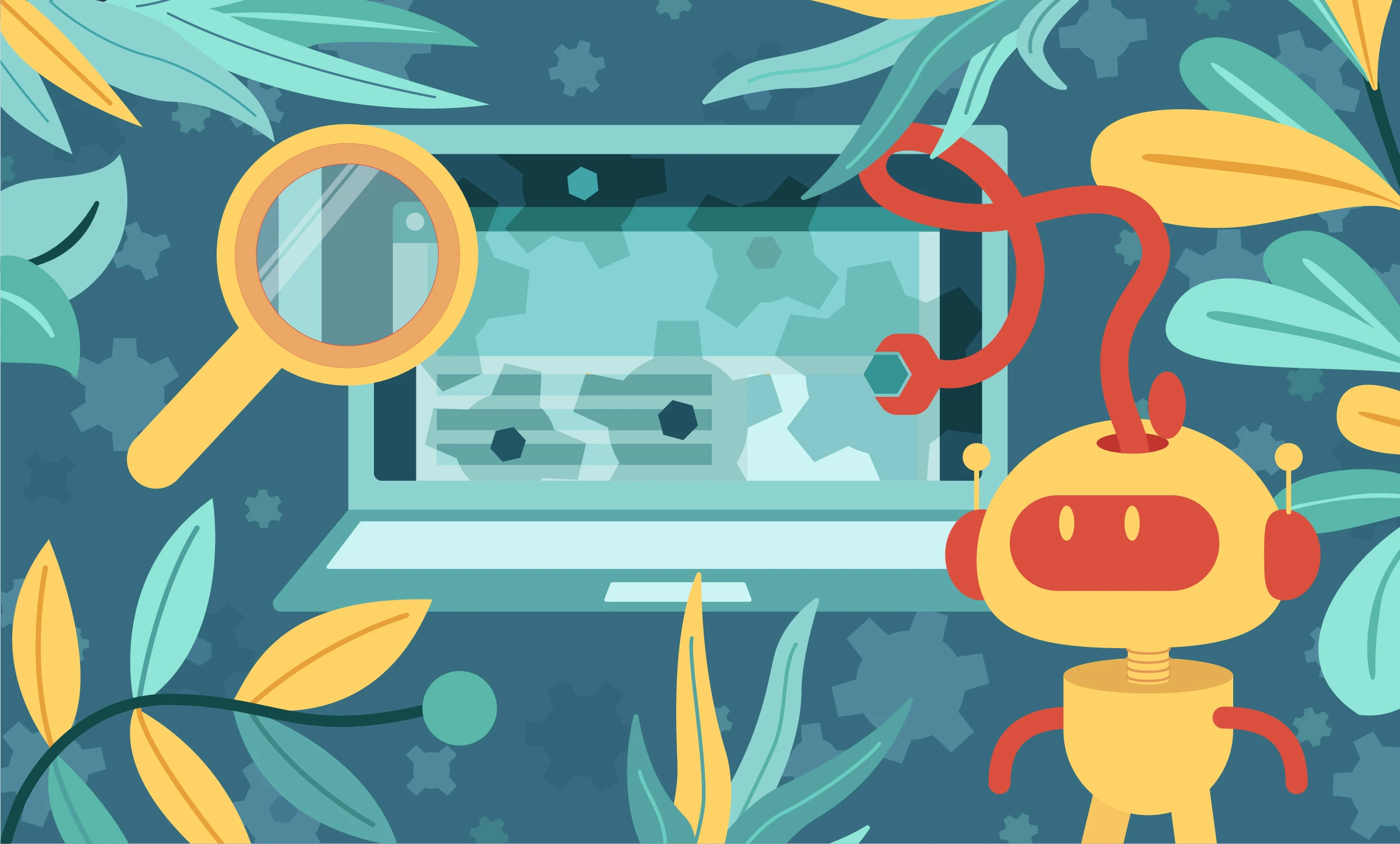
But for purposes of this article, we’re setting aside the fevered predictions of the future and focusing on the here and now: How to learn about and responsibly use these tools to be more productive today, with five tips for incorporating ChatGPT into your blogging workflow.
First things first: In order to use ChatGPT, you need to create a free account. As of early 2023, ChatGPT’s capacity is still stretched to its limits while they wrestle with unexpected demand — monthly users topped 100 million in January following December’s media blitz.
However, the most difficult part about gaining access to the tool is actually creating the account because unregistered users are deprioritized behind those already logged in. Don’t be surprised if you’re greeted with a “ChatGPT is at capacity right now” message on your first several attempts.
But don’t give up. It took a few days of trying during business hours before finally resorting to a late night visit to get it done. Have your phone handy, as you’ll need it for the account verification process.
Once you’re in, the best way to learn about ChatGPT’s capabilities is to jump in and write some prompts or ask some questions. You’ll quickly get a feel for how ChatGPT responds.
When you’re ready to move beyond the testing phase, you’ll want to keep a few things in mind before using it for professional purposes.
By now we’ve all seen the infamous ChatGPT output about egg-laying elephants. While a little on the extreme side, it’s unfortunately not that unusual. In fact, there’s even a note right on ChatGPT’s homepage admitting that it doesn’t always get it right.
Sometimes it produces outright inaccurate information, but more often it makes illogical assumptions, awkward phrasings and nonsensical story points.
In any event, as a professional content creator, proofreading and editing is a must (as you’ll note us repeating throughout this article).
One of my early tests of ChatGPT was a prompt to write a children’s bedtime story about a kitten and a ball of yarn. The first half of the story was sweetly charming, with Mittens the kitten playing inside with her owner.
But then things went logistically sideways after Mittens awoke from a nap and couldn’t find her ball of yarn:

Setting aside the abrupt change of scenery from indoors to outdoors, meowing yarn balls caught in a tree might be problematic to explain to the kids.
ChatGPT is always learning and refining its knowledge, but it might not be sufficiently up to speed on your topic at a given moment and could be filling in its own knowledge gaps with questionable information.
And more importantly, as it also notes right on its home page, ChatGPT is based on data collected up to 2021, so its usefulness for current events or recent changes in a given industry is limited.
In terms of productivity and speeding up content production, ChatGPT will be most efficient for topics where you’re already the subject matter expert. Or at least expert enough that you’ll know where to look to confirm what ChatGPT is outputting.
Of course it’s a fascinating tool for learning new things but for fact-checking purposes, you’ll achieve more efficiency when you can spot inaccuracies or data that needs to be double-checked before publishing.
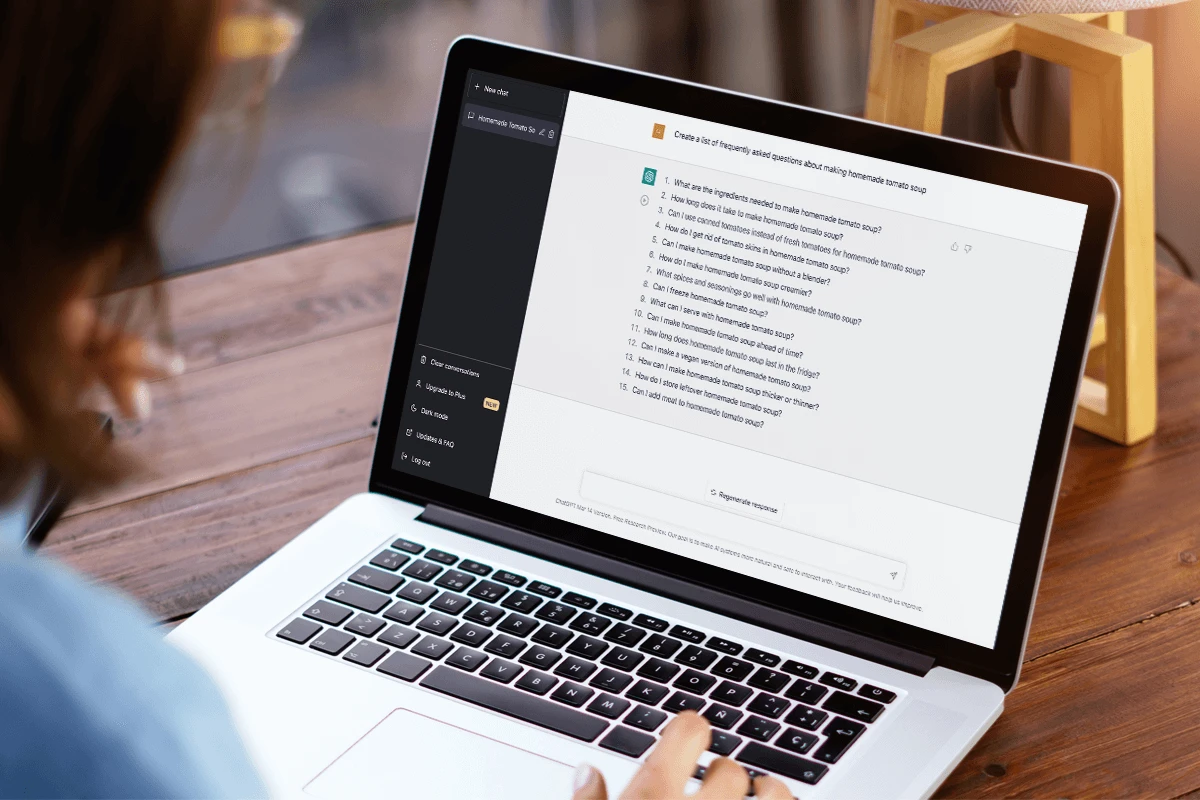
While ChatGPT is surprisingly impressive, it’s far from a copy-and-paste solution. In addition to ChatGPT taking poetic license with facts, the technology is still in its infancy as far as natural human speech is concerned.
In the few months since its debut, a considerable amount of its raw content has been published on the web, and it’s now quite easy to recognize the characteristic ChatGPT tone of voice (as editors have recently noted).
One of the dead giveaways is that ChatGPT frequently uses the same turns of phrases, such as “Looking for [a thing]? Look no further than [this].”
It will no doubt improve its language skills over time, but for now, publishing unedited ChatGPT output poses a number of risks, both in accuracy and obviousness.
So if you haven’t heard us already saying this by now in other channels, please take note: Generative AI tools might create impressively detailed content on some subjects, but what they can’t produce is YOU.
Think about your favorite novel: What did you love about it? Vivid imagery, evocative characters, the steady voice of the omniscient narrator, intense emotion, twisting story arcs. Now imagine ChatGPT rewriting that book.
Your loyal audience was drawn to you because of you. As more and more writers utilize ChatGPT, the more important your unique voice will be in ensuring that your content stands out and remains relevant.
With the caveats out of the way, we can move on to the good stuff. When used judiciously, ChatGPT can be very useful in managing a content business, as it can take over producing some of the more rote and time-consuming tasks of content creation.
While using ChatGPT, make sure you don’t overlook one of its more interesting features: A chat is meant to be a conversation, so if your first prompt doesn’t return an acceptable result, rephrase your ask. Add more detail or expand the question. ChatGPT will refine its approach and try again.
ChatGPT remembers and uses the information you provide in subsequent responses, so don’t hesitate to get granular with your prompts.
For illustrative purposes, we’ll use the example of writing an article about a tomato soup recipe. While our examples below might not be applicable to every writing niche, we hope that it inspires you to review your content production workflow to see where ChatGPT might be a good fit.
ChatGPT is in no way ready to replace full-featured SEO research tools and best practices. However, it’s quite handy for creating a list of subtopics related to your article.
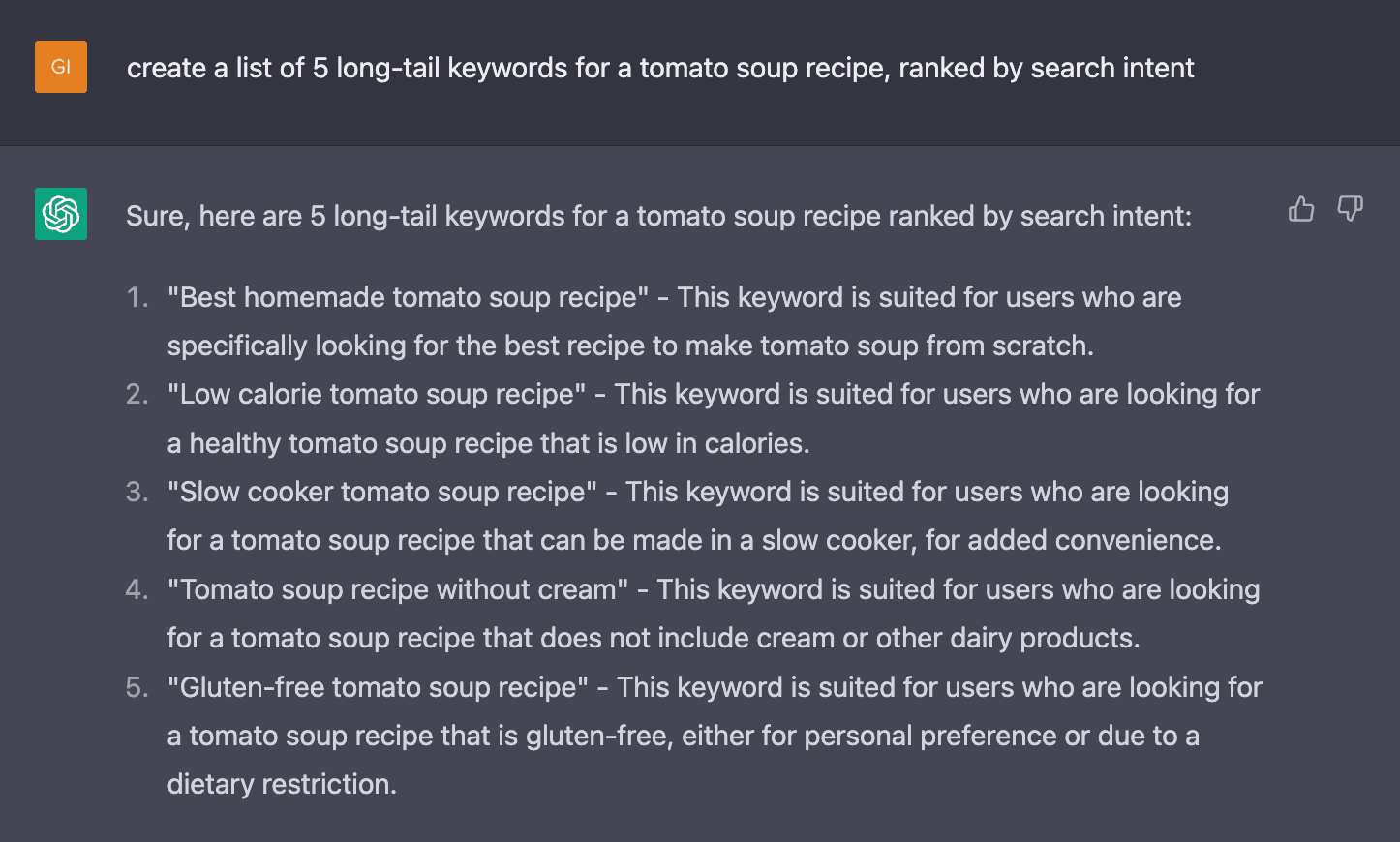
I usually ask for a list of 25 or 30 keywords. As you can see from the sample above, some of the results are long-tail keywords worth pursuing for your article, while others are suggestions that could be expanded into pillar content.
You can also ask for more detail on any of the keywords to have ChatGPT flesh it out for you.
ChatGPT is fairly adept at creating certain types of content within an article. If you’re publishing within the recipe, DIY, crafts, home decor or travel niches, for example, you might routinely include sections such as frequently asked questions, tips, what to pack for a trip, etc.
Using our tomato soup recipe example, here’s a partial list of FAQs generated by ChatGPT:
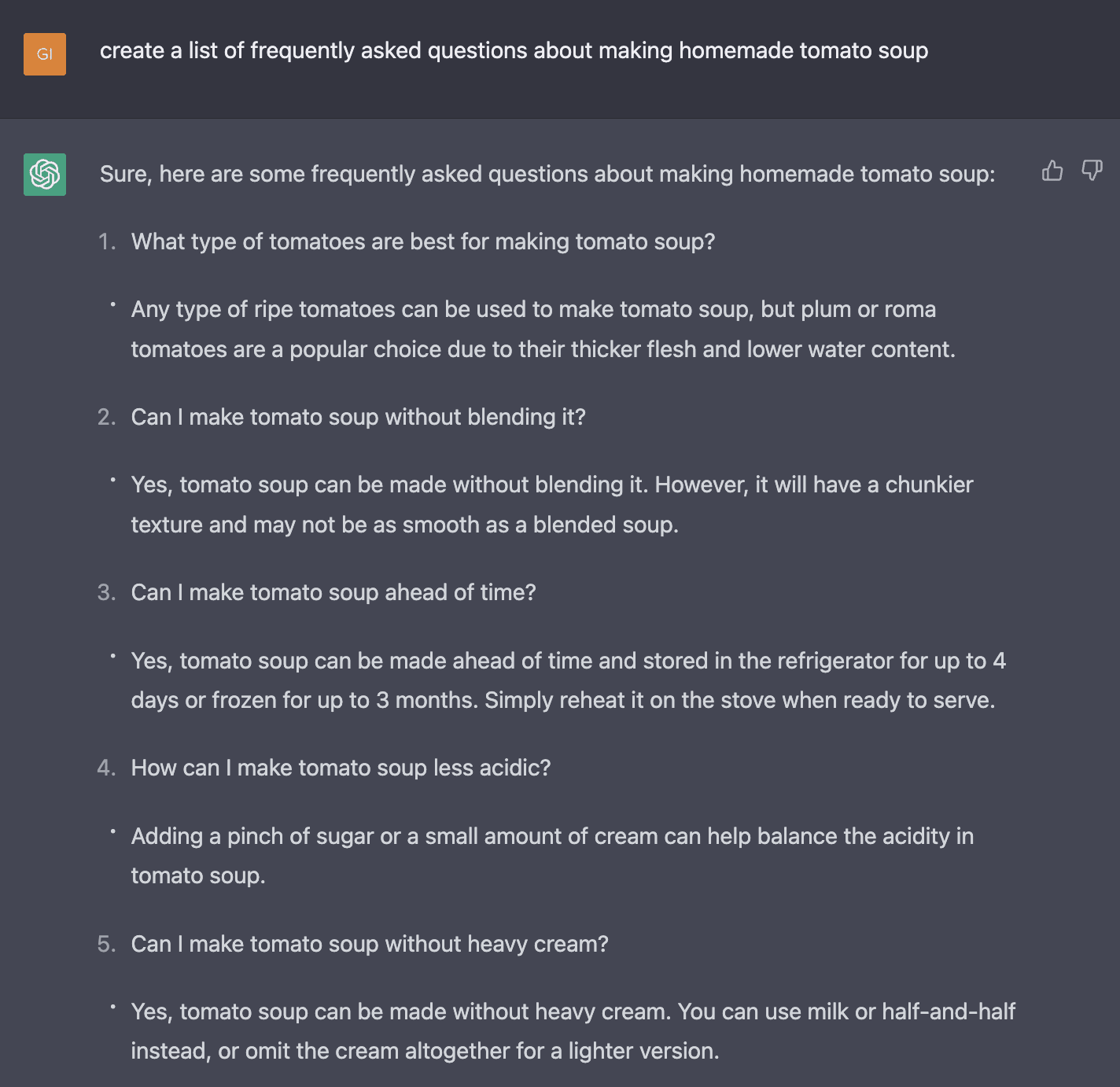
The output above is a good example of why ChatGPT output should never go unchecked. The answer to #3 will depend on whether the soup contains cream: Cream-based soups generally don’t freeze well.
And for #4, tomato acidity has other components besides flavor, including stomach irritation. ChatGPT’s answer addresses only one and misses an opportunity to point out that a pinch of baking soda can make tomato soup edible for those who have difficulties tolerating highly acidic foods.
One content task that I happily hand off to ChatGPT is creating meta descriptions. As of this writing, Google does not specifically use the meta description as a ranking signal.
Instead, Google might use an article’s meta description to populate a link’s description in the SERPs. So, rather than being a ranking factor, it becomes our article’s sales pitch: When a user scrolls through the list of sites on a search results page, they use that description to help them decide whether they want to click the link.
And since that space usually accommodates just 160 characters, we have to squeeze a whole lot of convincing into a few short sentences.
As you can see by this article, brevity is not my gift.
Even when I skip ChatGPT for content creation within my articles, it’s become a habit now to let it have the first crack at creating a meta description.
Here’s a great example of how asking for something in two ways generates different responses:
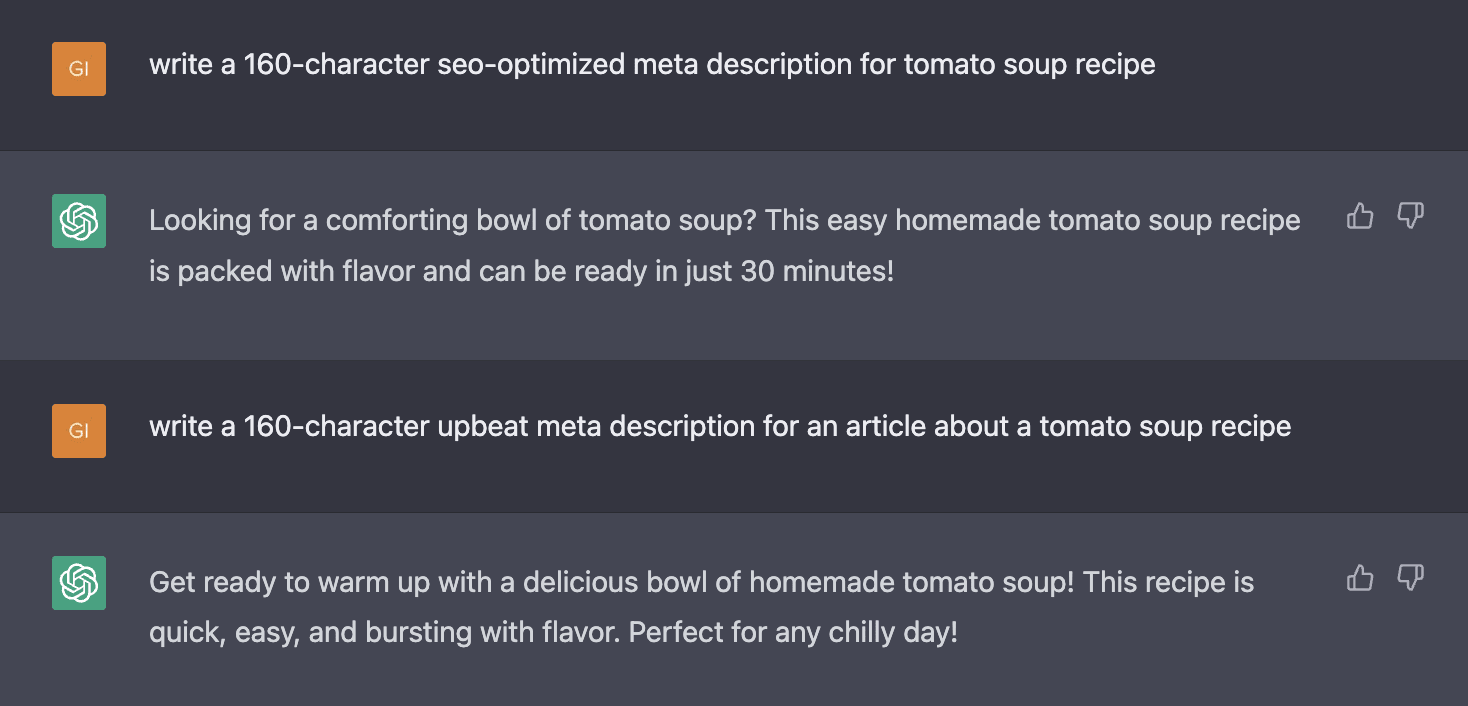
This output is also a good illustration of the first ChatGPT flaw mentioned above: Making assumptions about a topic when information is missing. I did not input a specific tomato soup recipe or instructions into the conversation, yet ChatGPT describes it as quick and easy in both outputs.
They also contain examples of ChatGPT’s use of turns of phrases. I frequently see “Looking for …” and also “Get ready to warm up with …” first sentences for winter-leaning recipes.
Remember, always be prepared to proofread and edit ChatGPT’s output, no matter the length.
While we’d never recommend letting ChatGPT take full charge of your content, having it create an introduction for your article is an easy way to spark your creative juices and get past that dreaded Blank Page Syndrome (a.k.a., writer’s block).
Again, don’t hesitate to rephrase your initial prompt with a different angle. You can usually drill down to a satisfactory response fairly quickly.
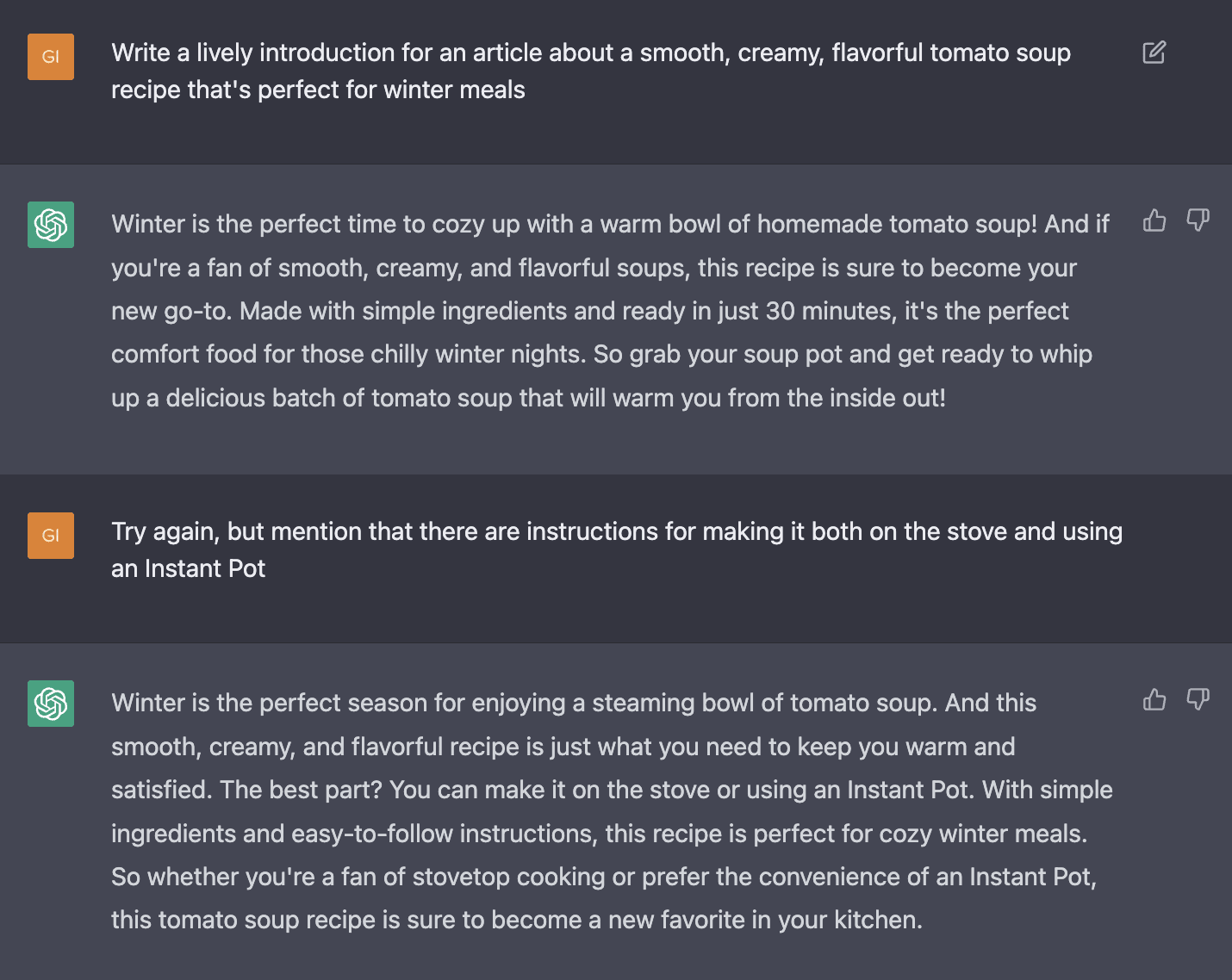
Similar to meta descriptions, I find ChatGPT particularly helpful in creating descriptions for social media promotions. These are the kinds of blurbs where I quickly end up in a rut, in terms of producing descriptions that are unique and appropriate for each platform.
I’m more than content to let ChatGPT loose on the salesy parts of my content marketing, which I then tweak for voice. Here are two sample Pinterest description outputs, each different from the other, depending on my prompt:
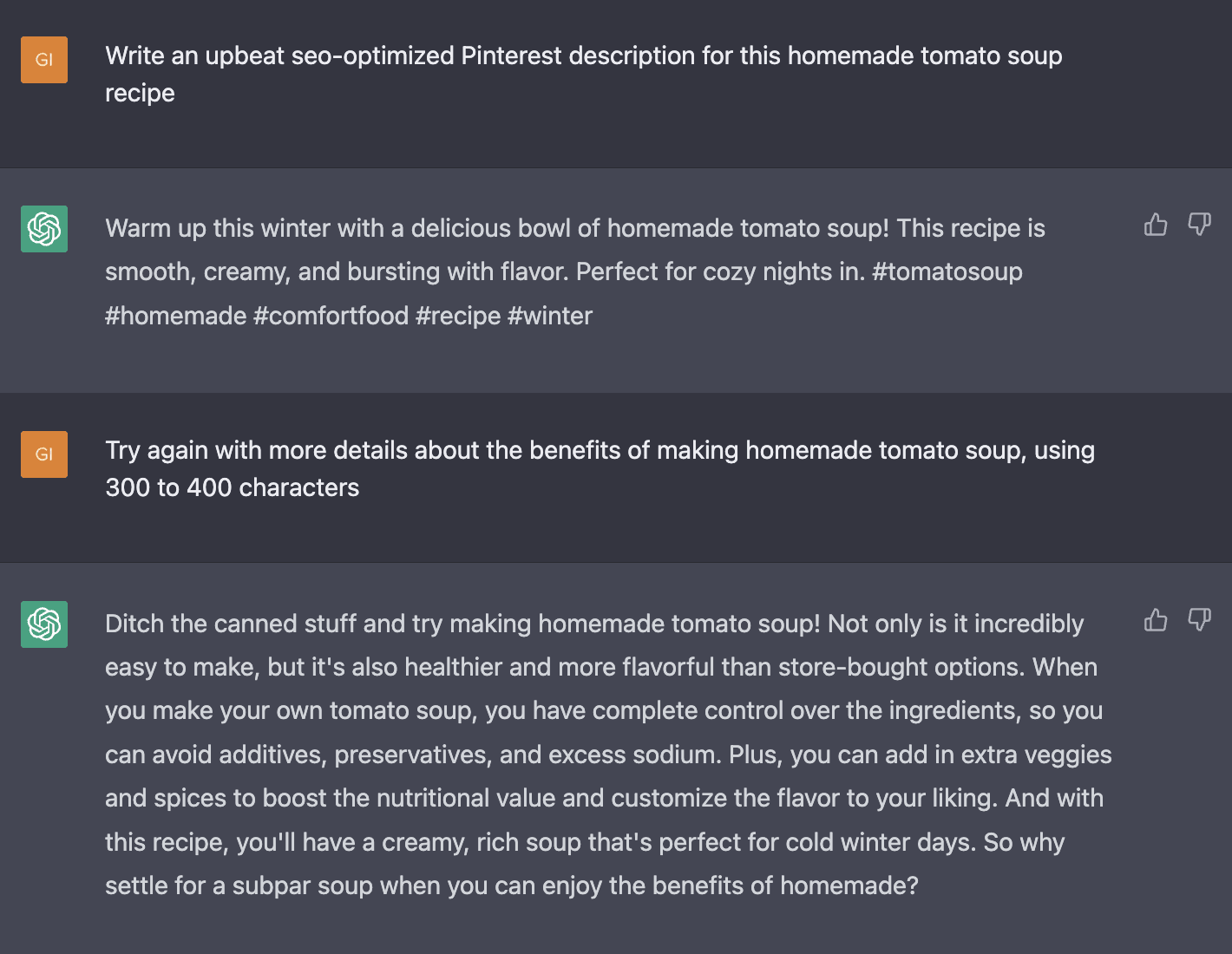
Notice that it remembers the “smooth” and “creamy” details from previous prompts.
Also note that, true to its 2021 heritage, it includes hashtags in Pinterest descriptions, which are no longer useful on Pinterest. It’s better to use standard SEO best practices to ensure that your pins find their way into Pinterest search results.
ChatGPT also sometimes can’t restrain itself to a fixed character limit, so make sure you double-check character count when it matters.
As we wrap up, we should clarify that this article was written by a human being. ChatGPT’s contributions were limited to screenshots of chats that occurred over several days.
While it’s not really possible to say here in March of 2023 exactly how things will change in the content creation industry, we only know that they will.
Our best advice for creators: Don’t panic, stay informed, enjoy the inevitable comic relief … and explore.
Stay up to date with the latest from Mediavine
Publishers spend time creating great content that keeps readers coming back, and we know that safeguarding that content and maintaining control over how it’s used are critical concerns in today’s …
 Eric Hochberger
Eric Hochberger
In a blog post last week, Google announced plans to launch generative AI into Search Labs with a new product called Search Generative Experience (SGE). What exactly is SGE, and …
 Brad Hagmann
Brad Hagmann
On behalf of all of us at Mediavine, Happy New Year! What better way to ring in 2023 than with our first installment of Behind the Numbers with Brad (BTNWB)? …